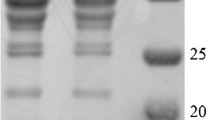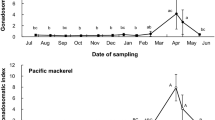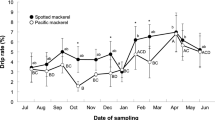Abstract
In order to reveal what role anaerobe muscle activity has on the fillet quality in Atlantic salmon (Salmo salar), 18 rested fish were killed on site and immediately filleted. One fillet was used as control group while the other was electrically exercised using 10 V, 5 Hz pDC for 3 min. Fillet weight and muscle pH was measured before the fillets were wrapped in aluminum foil and stored on ice. After 7 days muscle pH, color, and weight was measured. Texture profile analysis (TPA) was estimated using a 20 mm cylindrical probe compressing either at 40, 60 or 80% into the fillet and the shear force was estimated by slicing standardized muscles samples with a blade. Results show that electrical stimulation forces the muscle to contract and the muscle pH to drop by 0.5 units, leading to higher drip loss and loss of color. Comparing the fillets in pairs (paired t test) strengthens evidence on drip loss and color loss, but revealed also softer texture. Optimum compression rate for detecting differences in salmon muscle is at 60% compression. We conclude that electrical stimulation is a powerful tool for simulating anaerobe muscle activity enabling comparative studies within the same individual, hence isolating the variation amongst individuals and the location of sampling. Furthermore electrical stimulation reduces the need for live animal experimentation in quality studies.


Similar content being viewed by others
Reference
Morkore T, Rorvik KA (2001) Aquaculture 199(145):157
Roth B, Johansen SJS, Suontama J, Kiessling A, Leknes O, Guldberg B, Handeland S (2005) Aquaculture 250(830):840
Espe M, Ruohonen K, Bjornevik M, Froyland L, Nortvedt R, Kiessling A (2004) Aquaculture 240(489):504
Lavety J, Afolabi OA, Love RM (1988) Int J Food Sci Technol 23(23):30
Aksnes A, Gjerde B, Roald SO (1986) Aquaculture 53(7):20
Erikson U, Sigholt T, Rustad T, Einarsdottir IE, Jorgensen L (1999) Aquacult Int 7(101):115
Roth B, Moeller D, Veland JO, Imsland A, Slinde E (2002) J Food Sci 67(1462):1466
Roth B, Slinde E, Arildsen J (2006) Aquaculture 257(504):510
Kiessling A, Espe M, Ruohonen K, Morkore T (2004) Aquaculture 236(645):657
Olsen SH, Sorensen NK, Stonno SK, Elvevoll EO (2006) Aquaculture 258(462):469
Skjervold PO, Fjaera SO, Ostby PB, Einen O (2001) Aquaculture 192(265):280
Erikson U, Hultmann L, Steen JE (2006) Aquaculture 252(183):198
Erikson U, Sigholt T, Seland A (1997) Aquaculture 149(243):252
Roth B, Slinde E, Robb DHF (2006) Aquacult Res 37(799):804
Jerrett AR, Holland AJ (1998) J Food Sci 63(48):52
Norwegian Standard Association (1994)
Hunter RS, Harold RW (1987) 2nd edn, 1:411
Sigurgisladottir S, Hafsteinsson H, Jonsson A, Lie O, Nortvedt R, Thomassen M, Torrissen O (1999) J Food Sci 64(99):104
Bourne MC (1977) J Texture Stud 8(219):227
Proctor MRM, McLoughlin JV (1992) Proc R Ir Acad 92(53):59
Robb DHF, Kestin SC, Warriss PD (2000) Aquaculture 182(261):269
Hauck FR (1949) Trans Am Fish Soc 77(61):64
Sharber NG, Carothers SW, Sharber JP, House DA (1994) N Am J Fish Manage 14(340):346
Roth B, Imsland A, Moeller D, Slinde E (2003) N Am J Aquacult 65(8):13
Fletcher GC, Hallett IC, Jerrett AR, Holland AJ (1997) Food Sci Technol Lebensmittel Wiss Technol 30(246):252
Jerrett AR, Holland AJ, Cleaver SE (1998) J Food Sci 63(53):56
Jerrett AR, Stevens J, Holland AJ (1996) J Food Sc 61(527):532
Morkore T, Hansen AA, Unander E, Einen O (2002) J Food Sci 67(1933):1938
Olsson GB, Olsen RL, Ofstad R (2003) Lebenson Wiss Technol Food Sci Technol 36(125):133
Boggess TS, Heaton EK, Beuchat LR (1973) J Milk Food Technol 36(469):473
Azam K, Mackie IM, Smith J (1989) Int J Food Sci Technol 24(69):79
Marx H, Brunner B, Weinzierl W, Hoffmann R, Stolle A (1997) Z Lebn Unters Fors 204(282):286
Veland JO, Torrissen OJ (1999) J Sci Food Agric 79(1737):1746
Morkore T, Einen O (2003) J Food Sci 68(1492):1497
Schubring R (1999) Dtsch Lebensmitt Rundsch 95(373):386
Acknowledgments
Stjernelaks A/S and Henrik Ceder are acknowledged for supporting our experiments.
Author information
Authors and Affiliations
Corresponding author
Rights and permissions
About this article
Cite this article
Roth, B., Øines, S., Rotabakk, B.T. et al. Using electricity as a tool in quality studies of Atlantic salmon. Eur Food Res Technol 227, 571–577 (2008). https://doi.org/10.1007/s00217-007-0758-x
Received:
Revised:
Accepted:
Published:
Issue Date:
DOI: https://doi.org/10.1007/s00217-007-0758-x




